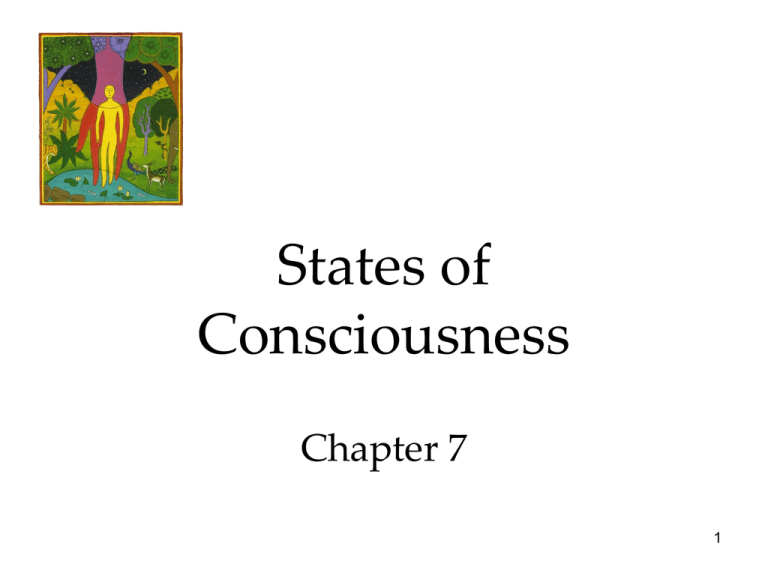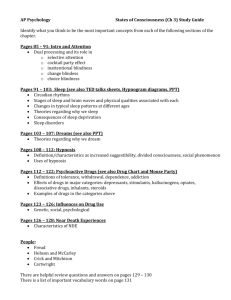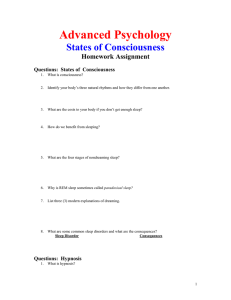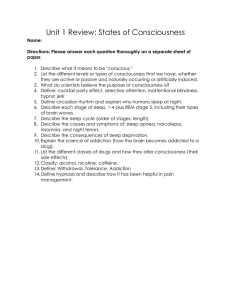
States of
Consciousness
Chapter 7
1
History of Consciousness
1. Psychology began as a science of
consciousness.
2. Behaviorists argued about alienating
consciousness from psychology.
3. However, after 1960, mental concepts
(consciousness) started reentering
psychology.
2
Forms of Consciousness
Consciousness: awareness of ourselves and our
environment.
3
Neuroscience & Consciousness
The Consciousness Lag:
-awareness of events/behaviors lags behind the response (unconscious)
Information Processing
Unconscious mind: processes information
simultaneously
Conscious mind: processes information
sequentially.
Conscious mind
Unconscious mind
4
Does the Menstrual Cycle Affect Moods?
Biological Rhythms
Biological rhythms are controlled by internal “biological clocks.”
1.
Annual cycles: seasonal variations in appetite, sleep, and mood.
Seasonal Affective Disorder (SAD) is a mood disorder people
experience during dark winter months.
2.
28-day cycles: The female menstrual cycle averages 28 days.
Research shows menstruation may not affect moods.
3. 24-hour cycles (Circadian Rhythms)Humans experience 24-hour
cycles of varying alertness (sleep), body temperature, and growth
hormone secretion.
4. 90-minute cycles: We go through various stages of sleep in 90minute cycles.
6
Rhythm of Sleep
Light triggers the
suprachiasmatic
nucleus to activate
pineal gland:
Melatonin:
-decrease
(morning = wake)
-increase
(evening = sleep)
7
Sleep Stages
Every 90 minutes, we cycle through 5 sleep stages.
How do we know this? – Sleep studies
8
Awake & Alert
During strong mental engagement, the brain exhibits
low amplitude and fast, irregular beta waves .
Fun Fact: A person involved in a conversation shows beta
activity!
Beta Waves
9
Brain Activity: Waves
10
Awake but Relaxed
Brain activity slows down to a large amplitude
and slow, regular alpha waves.
Fun Fact: Alpha waves are present during meditation!
11
Sleep Stages 1-2
Early, light sleep (stages 1-2): high-amplitude,
slow, regular wave form called theta waves .
Fun Fact: Theta waves are present while daydreaming!
Theta Waves
12
Sleep Stages 3-4
Deepest sleep (stages 3-4), brain activity slows down.
Large-amplitude, slow delta waves.
Fun Fact: If you talk or walk in your sleep, this is when you are likely to do so.
13
Stage 5: REM Sleep
After reaching the deepest sleep stage (4), the sleep cycle
starts moving backward towards stage 1.
Still asleep, the brain engages in low- amplitude, fast and
regular beta waves much like awake-aroused state.
-Muscles relaxed vs. increased brain activity, H.R., B.P. => Paradoxical
-Rapid Eye Movement (REM)
-REM Paralysis
-Most vivid dreaming
-Most learning takes place
14
90-Minute Cycles During Sleep
With each 90-minute cycle, stage 4 sleep decreases
and the duration of REM sleep increases.
15
Why do we sleep?
We spend 1/3 of our
lives sleeping…why?
Ideas?
Jose Luis Pelaez, Inc./ Corbis
16
Sleep Theories
1. Sleep Protects: Sleeping in the darkness when
predators loomed about kept our ancestors out
of harm’s way.
2. Sleep Recuperates: Sleep helps restore and
repair brain tissue.
3. Sleep Helps Remembering: Sleep restores and
rebuilds our fading memories.
4. Sleep and Growth: During sleep, the pituitary
gland releases growth hormone. Older people
release less of this hormone and sleep less.
17
Accidents
Frequency of accidents increase with loss of sleep
Canadian traffic accidents (1991-92)
18
Sleep Deprivation
1. Fatigue and subsequent death.
2. Impaired concentration.
3. Emotional irritability.
4. Depressed immune system.
5. Greater vulnerability.
All dream researchers believe we need REM sleep. When
deprived of REM sleep and then allowed to sleep,
we show increased REM sleep called REM Rebound.
19
Sleep Disorders
1.
Insomnia: Persistent problem falling or staying asleep.
2.
Somnambulism: Sleepwalking.
3.
Nightmares: Frightening dreams that wake a sleeper from
REM.
4.
Night terrors: Sudden arousal from sleep with intense fear
accompanied by physiological reactions (e.g., rapid heart
rate, perspiration)
5.
Narcolepsy: Overpowering urge to fall asleep that may occur
while talking or standing up.
6.
Sleep apnea: Failure to breathe when asleep.
20
Dreams
The link between REM sleep and dreaming has opened
up a new era of dream research.
What do you we dream about?
Why?
21
What do we Dream?
1. Negative Emotional Content: 8 out of 10
dreams have negative emotional content.
2. Failure Dreams: People commonly dream
about failure, being attacked, pursued,
rejected, or struck with misfortune.
3. Sexual Dreams: Men:1 in 10 dreams are
sexual; women 1 in 30.
4. Dreams of Gender: Women dream of men
and women equally; men dream more about
men than women.
22
Why do we dream?
“Why do I dream?”
“Well, there is NO DEFINITE ANSWER…
BUT…there are a few theories…”
1. Freudian Theory / Wish Fulfillment: In The
Interpretation of Dreams (1900) Sigmund Freud
suggested that dreams provide a psychic safety valve
to discharge unacceptable feelings.
Dream Content
“What actually happens”
Symbolic Transformation
“What it means” (interpretation)
hidden, unconscious desires & thoughts
being expressed
23
Why do we dream?
2.
Information Processing: Dreams may help sift,
sort, and fix a day’s experiences in our memories.
-cramming w/o sleep = No REM sleep = No memorization!!!
3. Physiological Function: provide the sleeping brain
with periodic stimulation to develop and preserve neural
pathways.
24
Why do we dream?
4. Activation-Synthesis Theory: random neural
activity => Dreams make sense of this activity.
5. Cognitive Development: brain maturation and
cognitive development.
- Babies need sleep!
25
Dream Theories
Summary
26
Hypnosis: Origins
Franz Anton Mesmer
- credit for hypnosis “discovery”
- mistakenly thought he
discovered “animal magnetism.”
- Some patients experienced a
trancelike state and felt better
upon waking up.
Franz Mesmer (1734 - 1815)
Hypnosis
A social interaction in which one person (the hypnotist) suggests
to another (the subject) that certain perceptions, feelings, thoughts,
or behaviors will spontaneously occur.
27
Aspects of Hypnosis
1. Posthypnotic Suggestion: Suggestion carried
out after the subject is no longer hypnotized.
2. Posthypnotic Amnesia: Supposed inability to
recall what one experienced during hypnosis.
28
Hypnosis: Fact or Fiction?
Those who practice hypnosis agree that its power resides in
the subject’s openness to suggestion.
Can anyone experience hypnosis?
Yes, to some extent.
Can hypnosis enhance recall of
forgotten events?
No.
Can hypnosis force people to act
against their will?
No.
Can hypnosis be therapeutic?
Can hypnosis alleviate pain?
Yes. Self-suggestion can
heal too.
Yes. Breathing &
concentration can do that
too.
29
Is Hypnosis an Altered State of
Consciousness?
Two Theories:
Divided Consciousness
Theory:
- Hypnosis = state of
dissociated (divided)
consciousness
(Hilgard, 1986, 1992).
Social Influence
Theory:
- Hypnotic subjects may
simply be imaginative
actors playing a social
role.
30
Yet another reason to say ‘NO’ to drugs:
After 4 years of ‘meth’
Drugs and Consciousness
Psychoactive Drug: A chemical substance that
alters perceptions and mood (effects
consciousness).
3 Types: Depressants, Stimulants, Hallucinogens
Terms you should know:
- Tolerance
- Withdrawal
- Dependence (physical & psychological)
32
Drugs & Neurotransmission
33
Misconceptions about Addiction
1.
Addictive drugs quickly corrupt.
Odds of getting hooked:
Marijuana:
Alcohol:
Cocaine:
Heroin:
Tobacco:
9%
15%
17%
23%
32%
Source: National Academy of Science (2003)
2.
3.
Addiction cannot be overcome voluntarily.
Is addiction a disease?
Addiction is no different than repetitive pleasureseeking behaviors.
But what’s the limit?
35
Influences on Drug Use
The graph below shows the percentage of US highschool seniors reporting their use of alcohol,
marijuana, and cocaine from the 70s to the late 90s.
36
Influences on Drug Use
Drug use = Biopsychosocial influences
Biological
Influences
Psychological
Influences
Social-cultural
Influences
Drug Use
37
Marijuana Use
The use of marijuana in teenagers is directly related to the
“perceived risk” involved with the drug.
38
Steve Jobs Last Words (really):
"Oh wow.
Oh wow.
Oh wow."
39
Near-Death Experiences
Can the mind survive the dying body?
Dualism: that mind (nonphysical) and body
(physical) are two distinct
entities that interact.
-N.D.E. = human
immortality (soul)
2.
Monism: mind and body
are different aspects of the
same thing.
-N.D.E. = brain stress =>
hallucinations
(From “Hallucinations” by R.K. Siegel. Copyright
© 1977 Scientific American, Inc. All rights reserved.)
1.




